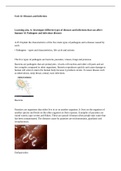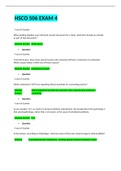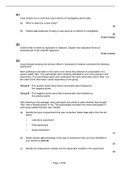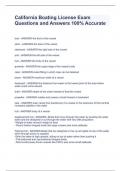1.1 LABORATORY ANIMALS
1.1.1 PREHISTORICAL TIMES
Aristotle (384-322 BC)→ most famous
● Made categories:Scala naturae
○ Stair like approach
○ Divided what he saw around him into different layers ased on complexity
○ Ranked all other material in respect to what he was as a human being
= introduction to the thinking of higher and lower beings.
Plutarchus (46-120)(Teacher of Pythagoras)
● I nvolve animals in ethical considerations
● Was a vegetarian → believed that animals and humans are equal
● Said there was no ranking
Galenus (129-216)
● Vivisection and dissectblooion of pigs
○ Wanted to investigate the anatomy and physiology
○ Look at the resemblance between humans
● There was a taboo on using human bodies
○ Uses monkeys and pigs as proxy for the human body
○ They were conscious :al and investigate how intestines work,..
● His knowledge prevailed until 17th century
1.1.2 MIDDLE AGESHOUSING
During the middlegroup agesChristianityreally prevailed
➔ They adopted thenatural order
➔ But they added a next step = angels, saints and God on the highest level.SC
● Natural order added with Angels and God
● Forsake animal instincts
○ Animal instinct = considered not good
○ You should not resemble an animal, but god
People should try to resemble god
➔ They are put closer to God than animal
➔ Larger distinction between human and animals
➔ Animals served human, you could do anything you want with them
No real progress
● Disease = a curse
● Cure = faith
1
,1.1.3 RENAISSANCE (14-16TH CENTURY)
Renaissance (14-16th century)
=Revival and critical view on the Ancient times
● Vesalius (1514-1564)
○ Corrected Aristotle and Galenus → used human bodies for dissections
○ Corrected mistakes deduced from dissection pigs & monkeys
- We are not the same as animals
- Creates a distance between humans and animals
● Van Leeuwen
○ I nvention of the microscope
Results:
● A different view on the position of humans
● The birth of a more scientific approach : u cannot base your principle on 1 observation
1.1.4 AGE OF ENLIGHTENMENT
Descartes (1596-1650)
● Theory ofi nnate knowledge: all humans were born withknowledge through the higher power of God
○ Combated by philosopher John Locke (1632–1704), an empiricist
○ His reasoning : all knowledge is acquired through experience
● ‘Je pense donc je suis’→ Importance of ‘reasoning’
○ I n case you can think, talk, express... → makes the subject important
○ Animals cannot express what they think → cannot talk, think, …
- They are machines (automata)
- So we can use them for what we want
Halen
● Measured blood pressure in 1748
○ Measured how high the blood has risen in the tube
● Animal experiments on conscious animals
● They saw the horse as a thing you could do experiment on, like a car
2
,I NDUSTRIALIZATION
⇒ Industrialization = people are replaced by machines
⇒ Less contact with animals, so less feeling of animal welfare
ogarth (1751)
H
=Four stages of Cruelty- story of Tom Nero’s live
= Aim of story : If you are cruel to animals, you will be a criminal later on
1) Nero as a child is playing with small animals
● Lot of cruelty → poking, shooting
2) Nero grew older and became a driver of a carriage
● Carriage was broken → blamed the horse → beat horse
● Cruelty on larger animal
3) Nero had a girlfriend
● Asked gf to steal jewelry → wanted to keep it → kills gf
● No respect for animal lifes and human lifes
4) Payback time
● He was taken by police → sentenced to death
● Al cruelty he did to animals and human were done on him
Kant (1724-1804)
● = Deontology
● Duties based on reasoning and not considering the outcome or consequences
○ Because we can reason, we have responsibility for others that can not reason
○ We need to take care of them
● Categorical imperative
○ Universal (for all and under all circumstances)
○ Treat human(ity) as a goal, never as a means
● Only (hu)man
○ The ‘reasoning’ is the key that decides what has dignity and what not
- I f there is no dignity or intrinsic value … it may be used (the categorical imperative
only applies to those having dignity)
T om Regan(see later) → animal right activist
→ based on the reasoning of Kant
→ We can judge the heart of a man by his treatment of animals
3
, Bentham (1748-1832) and Mill
● Utilism
○ Prevailing view of happiness
○ We want to make as much people happy (sick people that need research)
○ But we want to have as low as possible suffering (from lab animals)
○ Harm benefit analysis→ to minimize suffering
○
● They did not believe that Descartes was right
●
● Sentient beings
○ ‘The question is not Can they reason, nor Can they talk, but Can they suffer …’
○ Sentient beings are beings that can suffer → need to be taken into consideration
○
● Greatest happiness principle – utilism (utilitarisme)
○ Reasoning is less important than happiness
○ Considers the consequences of actions (<-> Kant)
○
● Calculus
○ Everybody to count for one, nobody to count for more than one.
○
● Agrees to the use of animals as long as the suffering is exceeded by the benefit for man
4






